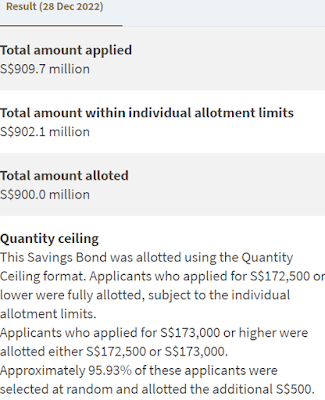I woke up to not one, not two, not three but four comments from readers regarding Daiwa House Logistics Trust and I took that as a sign that I would have to take some time off from gaming to blog.
Daiwa House Logistics Trust's IPO ends this Wednesday (24th Nov.)
IPO? I usually avoid IPOs because they are usually priced well for the seller and not for the buyer.
IPO stands for "it's probably overpriced?"
Is it more of the same in this case?
Looking at the information available, as an investment for income, Daiwa House Logistics Trust is not overly attractive to me.
For someone who is new to investing for income and who is just starting to build a portfolio, this could have a place.
However, with a distribution yield of 6.3% to 6.5% which is similar to what my two largest investments in REITs, AIMS APAC REIT and IREIT Global, are offering, Daiwa House Logistics Trust just isn't that attractive to me.
If I do invest in Daiwa House Logistics Trust, it would probably be because I would like more diversification.
However, it would be just geographical diversification which is less meaningful than diversifying into non-REITs.
This is especially so since my wish is to build a more resilient income generating investment portfolio.
Increasing the size of my investments in the local banks, DBS, OCBC and UOB, I believe would be more meaningful and Singapore banks make decent investments for income too.
Bear in mind that the banks pay only a fraction of their earnings as dividends while REITs distribute 90% to 100% of their income to their investors.
In this light, we could even say that the banks are more attractive than Daiwa House Logistics Trust as investments for income as what would be their dividend yields if the banks were to pay 90% of their earnings as dividends?
Banks also benefit from rising interest rates and while REITs can still perform well with higher interest rates when compared to bonds, they might experience some downward pressure.
Having said this, if Daiwa House Logistics Trust should see a significant decline in unit price, I might buy some.
The better investments I have made in REITs have almost always been post IPOs and that is saying something.
If I am wrong, it wouldn't be a tragedy as not making money is not the same as losing money.
Anyway, why am I not excited about this IPO other than the fact that I usually avoid IPOs?
After all, Daiwa House Logistics Trust is Japanese and some of my better investments were Saizen REIT, Croesus Retail Trust and Accordia Golf Trust.
The trio were all Japanese too and delisted subsequently, netting me some very nice gains.
I will continue to talk to myself.
1. Land lease.
Saizen REIT had only freehold Japanese residential buildings.
Croesus Retail Trust and Accordia Golf Trust had mostly freehold Japanese assets.
Daiwa House Logistics Trust will start with mostly leasehold Japanese assets.
Having more leasehold Japanese assets for their IPO helps to bump up their distribution yield as leasehold assets are usually cheaper while still commanding prevailing market rents.
This is especially the case for assets with much shorter remaining land leases.
VIVA Industrial Trust, anyone?
It helps to make the IPO look more attractive to investors.
Having mostly leasehold assets, the distribution yield really should be higher than the 6.3% at IPO.
The impression I get is that the IPO is probably priced more dearly.
If we look at past IPOs of S-REITs with mostly leasehold assets, most of their distribution yields were higher, if I remember correctly.
2. Japanese focus.
The Japanese focus of Daiwa House Logistics Trust might not last long since they have right of first refusal (ROFR) over 11 assets in Vietnam, Malaysia and Indonesia.
They market this as a good thing but one reason why I liked Saizen REIT, Croesus Retail Trust and Accordia Golf Trust was their focus on underappreciated and undervalued Japanese assets.
The Japanese market is probably more stable and less risky when compared to Vietnam, Malaysia and Indonesia.
3. Fund raising.
There are two things here.
We have been seeing some issuance of perpetual bonds by REITs to raise funds and the most notable is probably Lippo Mall Trust.
While perpetual bonds do not increase the gearing level of REITs, all else remaining equal, since they are treated as equity instead of debt, it is a form of financial engineering to make numbers look better.
Still, as long as the funds raised will help to improve performance and generate more income in a sustainable fashion for shareholders, it is a good thing.
I could be wrong but it is the first time I see a REIT having perpetual bonds issued at IPO and that makes me somewhat curious.
The second thing is that with the REIT being relatively small and with a relatively long list of ROFR assets, there could be more fund raising before long especially when the manager says they want to keep gearing below 40%.
Why start with only 14 Japanese assets and mostly leasehold ones with average remaining land lease of about 38 years?
Why not start with a larger portfolio and include most of these ROFR assets of which 17 are mostly Japanese freehold assets instead?
I have a couple of guesses but they are just guesses.
So, Daiwa House Logistics Trust, good or not?
As it is, Daiwa House Logistics Trust might seem decent enough for some as an investment for income but it isn't something I feel I must have in my portfolio.
It isn't screaming "BUY."
References:
1. VIVA Industrial Trust: 9% yield.
2. Saizen REIT.
3. Croesus Retail Trust.
4. Accordia Golf Trust.
5. Cutting losses in S-REITs.
6. Dividends from DBS, OCBC and UOB.


























